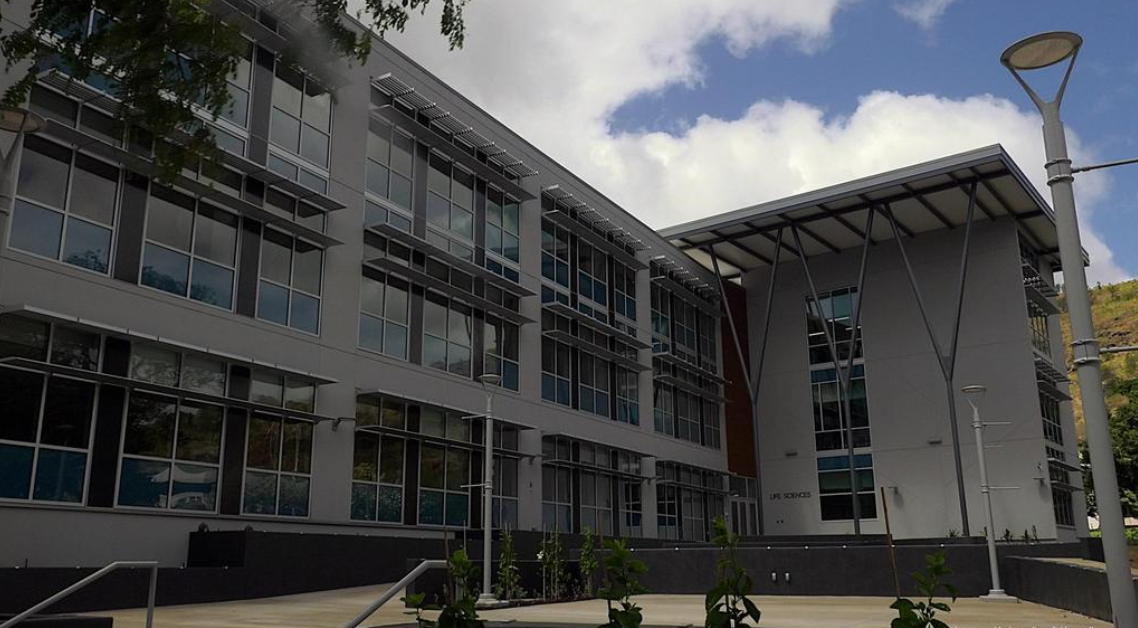A new beginning for the University of Hawaiʻi at Mānoa with the completion of the Life Sciences building that will open for instruction in the fall 2020 semester. Located on the Diamond Head end of McCarthy Mall, the three-story, 70,000-square-foot facility with 21 state-of-the-art teaching and research laboratories, was built to serve more than 500 students daily and support world class research.
“This building was designed and constructed purposely to bring together many of our most-accomplished researchers with undergraduate and graduate students,” said UH Mānoa Provost Michael Bruno. “The interdisciplinary collaboration that will happen in the new facility offers an exciting opportunity for our students, our future researchers and leaders.”
The $65 million facility will be home to the College of Natural Sciences biology, microbiology and botany departments along with the Pacific Biosciences Research Center (PBRC), which operates the state’s only transmission electron microscope. Along with the 21 modern laboratories (six teaching, 15 research labs), the building also features a 600 square foot student collaboration area, 52 graduate student workstations, five conference rooms and 28 faculty offices.
“We are extremely excited that the Life Sciences building is ready,” said UH Mānoa College of Natural Sciences Dean Aloysius Helminck. “It’s a fantastic opportunity, a collaboration between several different units on campus to provide absolutely top-notch, world-class facilities for both research and instruction.”
“We cannot thank state lawmakers and the governor enough for supporting this project,” said UH President David Lassner. “Beyond the amazing educational and research opportunities that the facility offers our students and scientists, it also provided the university an opportunity to prove that it could efficiently build a facility that will advance 21st century teaching, learning and research.”
Vision turns to fruition
In 2016, university leadership committed to a new campus modernizing strategy–designing university space to foster interdisciplinary collaboration and communication that will also support modern teaching, learning, innovation and scholarship. Maximizing the efficiency of both capital and operational dollars was a critical component of the strategy.
The Life Sciences Building is the university’s first major design-build project, a single contract for the design and construction with a fixed cost. Design-build projects are more likely to be completed on time and with fewer cost overruns, compared to the typical design-bid-build process. The university partnered with Layton Construction Company, LLC, and its design consultant G70 for the Life Sciences project.
“The working relationship with Layton and G70 and the university was a true partnership,” said UH Vice President for Administration Jan Gouveia. “Everyone involved was committed to delivering a quality project.”
Gouveia added that for a project of this magnitude to go from concept to completion in just four years is a testament to the perseverance and commitment to the highest standards of everyone involved.
“Contributions from our design-build, construction management, campus operations, environmental health and safety, procurement, and fiscal offices, along with our dedicated faculty, made this modern instructional and research facility a reality,” said Gouveia. “Leadership from the College of Natural Sciences, PBRC and the Office of the Vice Chancellor for Research, was instrumental in programming the synergistic activities within the LSB to advance cutting edge collaboration amongst multiple disciplines.”
The UH Office of Project Delivery is responsible for just about every major capital improvement project for the 10 campus UH System, including Life Sciences. The office has been completely transformed over the last five years–adopting industry best practices, implementing a new project management system and centralized online system for issuing solicitations and receiving proposals or bids and assembling a team of experienced construction professionals to manage the project.
The next major project on the UH Mānoa campus is a $41 million, design-build to renovate the Sinclair Library into a student success center, which state lawmakers funded in 2019.
Iconic McCarthy Mall upgrade
The Life Sciences Building is an upgrade for McCarthy Mall, one of the iconic locations on campus. The new building is located on East-West Road between Kennedy Theatre and Moore Hall and across the street from Lincoln Hall and the Center for Korean Studies Building.
“This building is now the anchor on the Diamond Head side of McCarthy Mall along with Kennedy Theatre, one of the primary entrance points and certainly one of the most loved areas of our campus,” said Bruno.
The buildingʻs open courtyard overlooks the mall and is conveniently located next to Hamilton Library and Paradise Palms Café. The Life Sciences houses six teaching laboratories, 15 research laboratories, 52 graduate student workstations, five conference rooms, twenty-eight faculty offices, a 600 square foot student collaboration area and an approximately 3,000 square foot shell space to allow for future office expansion.
The final phase of the project is the demolition of Snyder Hall, which is also along McCarthy Mall. That phase is expected to be completed in the summer of 2021.
